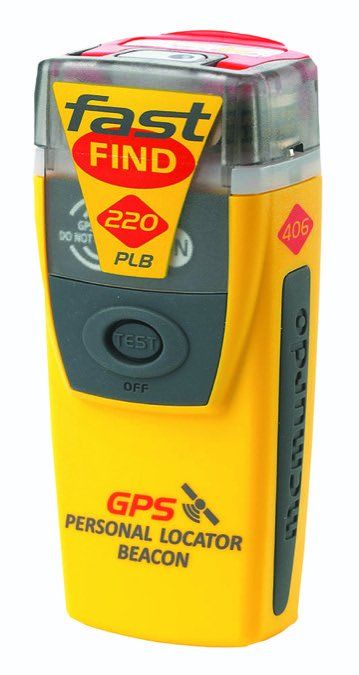As pilots, we long ago learned that once we point the nose of our aircraft away from metropolitan areas it is often only minutes before we are over terrain that is sparsely populated at best. West of the Mississippi or over the Alleghenies, it’s not unusual for much of our flight time to be over what seems to be miles and miles of nothing but miles and miles.
That’s what makes investing in a personal locator beacon, or PLB, an easy decision as a belt-and-suspenders backup for the aircraft’s ELT. Plus, if you survive the ditching in the boonies, you can take a PLB with you should you have to hike.
But if you haven’t shopped the PLB market in a while, the latest tech can be confusing so we rounded up a handful of models to see which were among the best value. Here’s a report.
We’re Always Listening
Bluntly, when it comes to successful SAR (search and rescue) for someone in distress in the toolies, the pros who are listening for distress calls and have the resources to come get you are doing so via satellite-based 406 MHz receiving equipment.
Relying on a 121.5-only transmitter in an emergency may just give you the answer to the question as to whether a tree falling in the woods without anyone hearing it makes any noise.
We’ve observed that a significant portion of the aircraft rental fleet in the country is still equipped with 121.5 MHz-only ELTs. If you’re a pilot who either has no access to an aircraft with a 406 MHz ELT or does, and wants a backup device because you recognize that an ELT may not trigger, its signal may be blocked due to the dynamics of an accident or the ELT can sink with the aircraft, what are your alternatives?
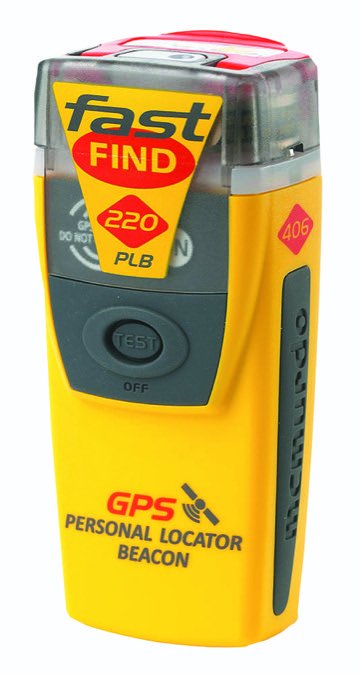
It’s easy; buy a PLB. It easily fits in the pocket of your survival vest. It transmits on 406 MHz and 121.5 MHz. It’s less than half the price of an ELT. It doesn’t require a paying for an ongoing subscription for it to work (I keep thinking of the folks who have an accident shortly after forgetting to renew their insurance).
If you don’t have a PLB, we think now is a good time to buy. As we’ll talk about in a moment, the selection is excellent and the prices are reasonable.
Buy and Forget
A PLB is pretty much “buy and forget.” Once you buy it, you go through a one-time, free registration procedure via the internet (www.beaconregistration.noaa.gov) so that if it’s triggered the SAR folks can call you to see if it’s a false alarm. You then stick it in your survival vest. (You do have a survival vest? See the February 2015 issue of Aviation Consumer-you want your most important survival equipment with you when you get out of the airplane.)
Once the PLB’s in your vest, it becomes one of the things you check during your inventory of your vest as one of the things that pops up on your aviation calendar every six months-inventory the survival vest and take recurrent flight training (you do that, too, right?). During that inventory, you check the ELT battery. If it’s still good, you put it back in the vest. It should last six to nine years. Once it’s slipped its mortal coil you check to see if it’s cheaper to send the PLB in for a battery replacement or buy a new unit-to date it’s generally been cheaper to buy a new PLB and 86 the old one.
While some PLBs are capable of sending messages-an option that requires a subscription-a PLB is not a communication device; it is purely designed to let SAR know that you need help and guide rescuers to you. Before making a PLB purchase, you need to decide whether you want a communicator or a dedicated life-saving device for which you do not have to make ongoing payments.
How SAR Works
When you activate a PLB, it transmits a powerful signal at 406 MHz, an internationally recognized distress frequency monitored in the U.S. by the National Oceanic and Atmospheric Administration (NOAA), the Air Force Rescue Coordination Center (AFRCC) and the United States Coast Guard (USCG). The signal is sent to a network of U.S., Russian, Canadian and French weather and global navigation system satellites that are part of the COSPAS-SARSAT international satellite-based search and rescue system (SARSAT is an acronym for “Search and Rescue Satellite Aided Tracking”).
The international COSPAS-SARSAT system is based on a network of satellites in low-altitude earth and geostationary orbit as we’ll as ground receiving stations and control and coordination centers. Its mission is to provide accurate and reliable distress alert and homing data. Since its launch in 1985, the COSPAS-SARSAT system has helped save more than 26,000 lives.
When activated, a PLB sends two signals: 406 MHz (which carries the unit’s unique identifying number-UIN-and GPS data to the satellites) and 121.5 MHz. SAR operations then comprise three steps: alert, homing and rescue. The alert and homing phases used the same 121.5 MHz analog frequency up until 2009, when COSPAS-SARSAT decided that it would phase out satellite processing at the 121.5 MHz frequency and that alerts would be triggered only on 406 MHz, digital frequency able to offer enhanced security, to provide more comprehensive information and to reduce the number of false alarms.
After receiving your transmission, the satellites “fix” on your location using frequency of arrival (FOA) and time of arrival (TOA) methods, then relay your information to the AFRCC or the USCG depending on
the location of your alert. If you use a GPS-compatible PLB, it can deliver your GPS coordinates (within less than 100 meters) to SAR personnel through the satellite system. This information is passed on to local SAR authorities who will come to your assistance.
Even without GPS, the 406 MHz signal from the satellite will get rescuers to within five kilometers of your position. Then search-and-rescue teams will use a tracking device to home in on the 121.5 MHz and the 406 MHz frequencies.
Many PLBs include a built-in LED signal light to help rescuers find you once they get close.
Registration

Federal law requires that all PLBs be registered in the NOAA SARSAT database. Registering your device is free of charge and the data is protected and only shared with rescue forces when your PLB is activated. When you register, NOAA will link your essential personal information to a 15-character code known as a Unique Identifying Number (UIN). When activated, the PLB transmits your UIN to the COSPAS-SARSAT satellites via electronic bursts.
While the electronic bursts provide search-and-rescue units with your location, the UIN tells them personal information such as your name, address, phone number and any medical conditions you may have.
Transmission Time
A PLB comes equipped with a lithium battery that remains dormant until you activate the PLB. By COSPAS-SARSAT regulations there are two classes of PLBs, based on battery capability: Class 1-the heavy-duty battery must be able to transmit at -40F (-40C) for 24 hours. Class 2-the battery must be able to transmit at -20F (-28.9C) for 24 hours.
A PLB must be certified by COSPAS-SARSAT and the FCC before it can be sold in the U.S. That COSPAS-SARSAT certification process, including lab testing, is a big deal; it typically takes a year or more. Human lives depend on PLBs.
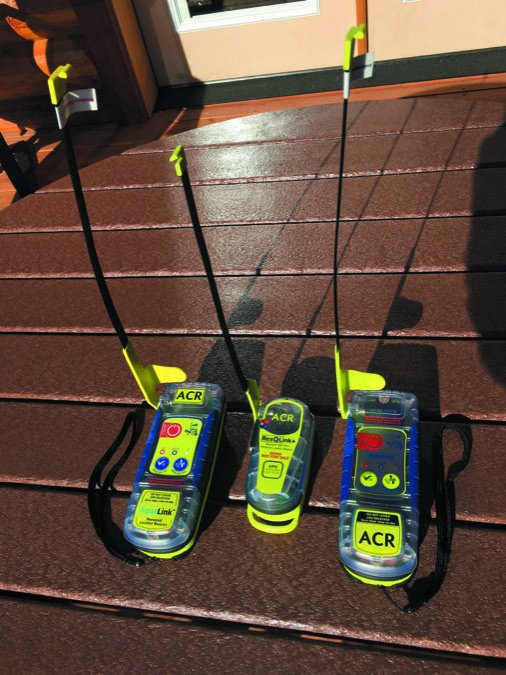
With all that as background, we surveyed the market to see what’s available and what we’d like to have. We’ll note here that most of the PLBs we surveyed are water resistant/proof to some degree, but few of them float unless they are in a buoyancy pouch-and none will transmit from inside the pouch.
Finally, because you may have only one working hand following an accident, it is our opinion that any PLB you purchase should be capable of single-handed activation. All that we reviewed were capable of one-hand activation, although some were easier than others.
Cobham/ACR
A long-established beacon company, Cobham (www.cobham.com), and its subsidiary ACR, put out four PLBs, all with Category 2 batteries, that vary only in size and features. All have an identical activation procedure: Deploy the antenna, press the “on” button and give the antenna a clear view of the sky. All models recommend battery replacement within six years of manufacture or five years of being placed in service (and immediately after being activated) and come with five-year warranties. All are waterproof to 16 feet.
• At 4.6 ounces, the ResQLink is a more than adequate PLB that includes an internal GPS. It does not float. It is one of the smallest, lightest PLBs on the market. Our search revealed prices as low as $244. A floatation pouch is available for separate purchase for about $20. A built-in strobe comes on when the unit is activated.
In its stowed position, the antenna wraps around the body of the unit. Unclipping it is not intuitive; we had to watch a video to determine how to do it. Once we figured it out, it was easy to do one-handed.
• ACR’s ResQLink+ weighs 5.4 ounces and differs from the basic ResQLink only in that it floats. Interestingly, we found it on Amazon for a dollar less than the non-bouyant unit-$243.
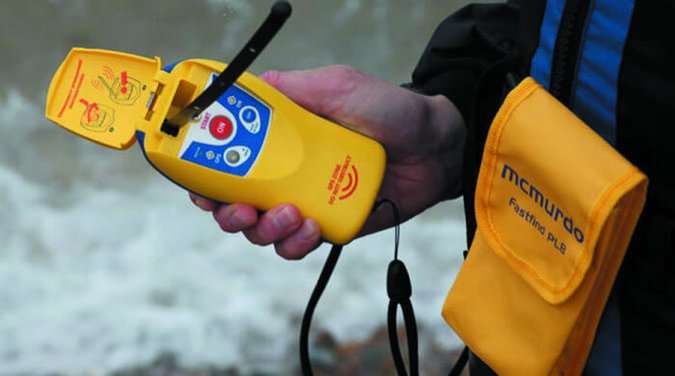
While it floats, the ResQLink+ floats face down, so it’s not possible to let the device bob along beside you in the water while it’s transmitting. You’ve got to get it onto a surface where the face of the unit is pointed at the sky and the antenna is clear of the water.
• ACR’s AquaLink is a larger version of the ResQLink line that floats. It also has the antenna wrapped around the body when stowed, but we think deployment of the antenna is slightly more user friendly and may be less likely to frustrate a passenger who hasn’t been briefed on its operation. It also can be deployed one-handed.
We found street prices as low as $325 for the AquaLink; however, we do not feel that it has any features beyond those of the ResQLink+ and saw no reason to spend the extra money.
• ACR’s AquaLink View PLB takes the AquaLink one step up by incorporating a digital display that allows you to monitor the beacon’s operational activities and displays your lat/long. It also displays operating instructions for the unit.
The AquaLink View will allow you to send “I’m OK” messages via a subscription service. It also walks the user through the unit’s self-testing procedure. We saw street prices as low as $360.
McMurdo
The McMurdo (www.mcmurdogroup.com) Fast Find 220 comes close to the ResQLink in the race for smallest PLB and costs about the same. It does not float, so it requires the floatation pouch that comes with the unit for buoyancy. We saw street prices as low as $246.
Activation involves pulling a tab and removing the top of the unit. The antenna unfurls either by itself or with a nudge by the user. With the Fast Find on its back, the antenna points directly upward. All that is left to do is press the “on” button. Activation can be carried out with one hand.
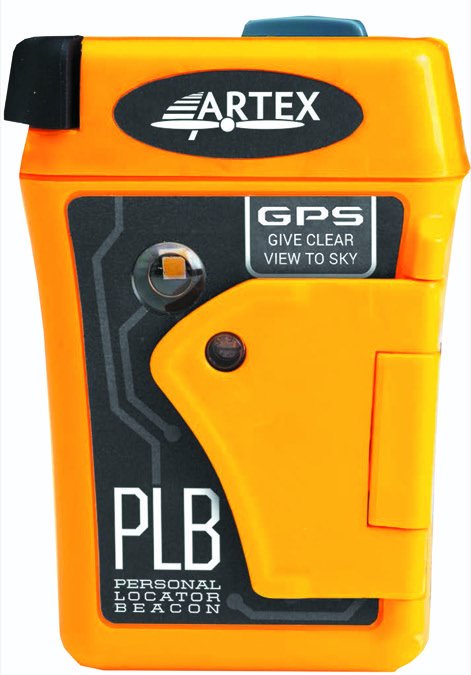
Battery life is advertised as six years; however, when preparing this article we ran the battery test on the Fast Find we purchased more than nine years ago and it checked fine.
The Fast Find Max G is essentially a bulked-up 220-having the same features but enclosed in what is described as a shatterproof case, it floats and will transmit for 48 hours rather than the 24 hours promised by all the other PLBs we surveyed. On the plus side, the unit has a user-replaceable battery pack, something we have not seen with other PLBs. We found street prices as low as $487. Unless you need a PLB that will probably withstand greater impact forces than you or you require twice the transmission time of a standard PLB, we would stick with a lower-priced unit.
Artex
The Artex (www.acrartex.com) PLB is also one of the very smallest we reviewed. The activation procedure is claimed to be one-handed, although you have to wedge the unit against something as you pull the antenna out of the body. After that, you flip open the flap to uncover the “on” button and press the button.
As with the smallest of PLBs, the Artex does not float, but it has an attractive street price-we saw as low as $269 at Aircraft Spruce (www.aircraftspruce.com).
Ocean Signal
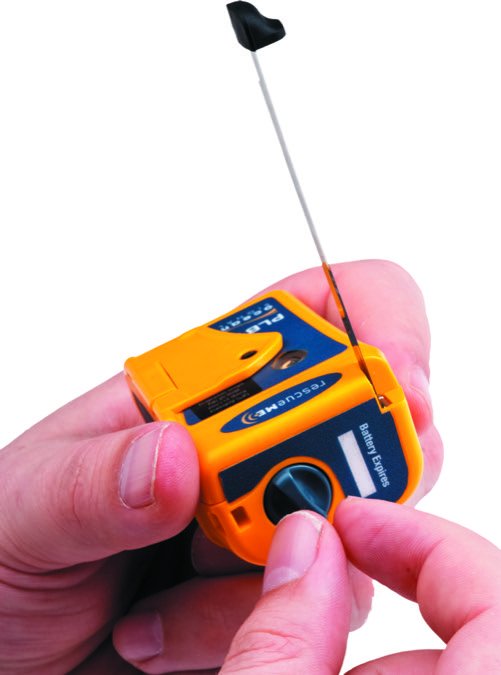
At 4.2 ounces, Ocean Signal’s RescueME PLB 1 takes the title of the smallest PLB. Its appearance is nearly identical to that of the Artex unit, including the same activation procedure. Battery life is advertised as seven years. The street price we observed, $249, is also attractive.
As with most other units, the RescueME floats only with a floatation pouch and will not transmit from within the pouch.
Breitling Emergency
There is one PLB that is ordinarily worn rather than being carried in a pocket or emergency vest. It’s a part of one of the more expensive wristwatches on the market, the Breitling Emergency.
At a street price of $16,000, give or take a few hundred bucks, the market for the Emergency is, according to Breitling (www.breitling.com), limited. However, the PLB portion of the watch is no joke-Breitling went through a staggeringly expensive R&D process to miniaturize a PLB and an antenna suite, create a rechargeable battery (every few months in a dedicated charger) and then go through the certification process in a number of countries. It does not have a GPS.
As we researched this article, welearned that if you own a PLB and travel to a country where that make is not certified for sale and you have an emergency and trigger it, you will not be refused rescue.
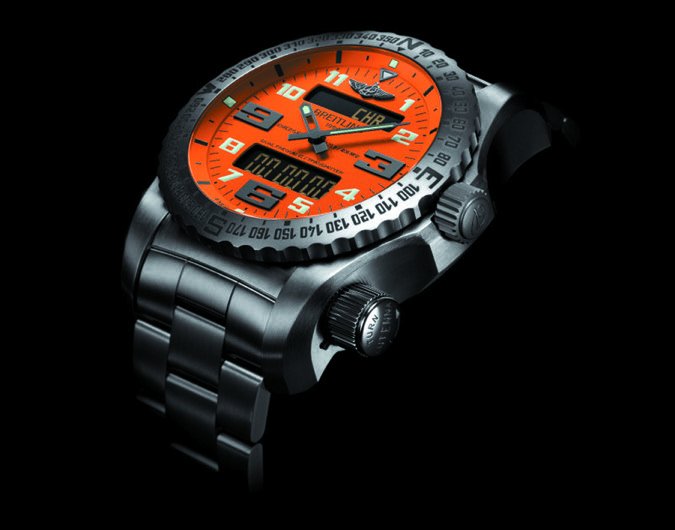
In our opinion, Breitling’s Emergency PLB watch is not a gimmick. On the market in the U.S. since 2015, there are reports of users in life-threatening situations triggering the PLB and being rescued.
The antenna system of the Emergency has two extendable sections housed in the lower part of the watch. They are extended by unscrewing the cap on the right side of the watch. The cap comes free as the antenna deploys. Activation is one-handed only, in our opinion, if the wearer can use the hand on the arm not wearing the watch.
The transmitter transmits alternately on 121.5 and 406 MHz in a fashion that automatically uses the portion of the antenna length as required for the wavelength of the transmission.
A notable part of the development of the Emergency was a tiny battery that could support the power output demands of the alternating radio frequency transmissions-30 mW for 121.5 MHz and more than 100 times higher for 406 MHz: 3.2 W.
SELECT PERSONAL LOCATOR BEACONS COMPARED | |||
DEVICE | SIZE AND WEIGHT | FEATURES | STREET PRICE |
ACR ResQLink ACR ResQLink+ ACR AquaLink ACR AquaLink View | 1.3 x 1.9 x 3.9 inches. 4.6 ounces. 1.6 x 1.9 x 4.5 inches. 5.4 ounces. 2.3 x 5.8 x 1.45 inches. 9.2 ounces. 2.3 x 5.8 x 1.45 inches. 9.2 ounces | GPS, strobe, class 2 battery GPS, strobe, floats, class 2 battery GPS, strobe, floats, class 2 battery GPS, strobe, floats, class 2 battery, view screen | $244 $243 $325 $360 |
McMurdo Fast Find 220 McMurdo Fast Find Max G | 4 x 1.8 x 1.3 inches. 8 ounces. 5.7 x 3 x 1.3 inches. 9 ounces. | GPS, strobe, class 2 battery GPS, no strobe, floats, class 2 battery, 48-hour transmit time, user-replaceable battery pack | $246 $487 |
Artex | 3 x 2.1 x 1.3 inches. 4.9 ounces. | GPS, strobe, class 2 battery | $269 |
RescueME PLB 1 | 3 x 2.1 x 1.3 inches. 4.2 ounces | GPS, strobe, class 2 battery | $249 |
Breitling Emergency Watch | 0.85 inches thick, 2 inches diameter. 5 ounces (without watch strap). | Integral to a watch, category 2 rechargeable battery | $16,000 |
Conclusion
We think a PLB is cheap insurance for anyone who flies over even slightly remote areas. If the pilot also engages in hiking, boating or other sports that take her or him away from civilization it’s an additional reason to own a PLB.
Due to the rigorous certification process, we are of the opinion that you won’t go wrong with any of the GPS-equipped ones we surveyed. Because we keep our PLB in our survival vest, size and weight matter. We prefer small and light-and at we’ll under a pound, most of them fall within our operating definition of “lightweight.” By the same token, if you’re also in the market for a seriously high-end timepiece, we think buying one with an integral PLB, even without GPS, makes sense.
While we don’t think you’ll go wrong with any of the GPS-equipped PLBs, we lean toward the ResQLink+, just because it is not only waterproof, it floats without needing to be stuffed inside a pouch.

